Critical Vectors
Investigators are often called upon to make sense out of a tangle of confusing or contradictory material and to find out how it impacts on the investigation. Experienced investigators may rely on their intuition, or assess the information against a reasonable hypothesis. The above diagram represents a theoretical model for a process by which the value or significance of information for an investigation may be assessed.

The first step is to consider is whether the information constitutes fact or speculation. To a certain degree this requires an investigator to use his or her training and experience to make a value judgement. In some criminal intelligence systems and procedures this is achieved by assigning a code to the information based on (a) the track record of the person providing the information (i.e. ‘the source’) and (b) his or her proximity to the origin of the information. However, assessing the reliability of a source is a long way from assuring the validity of the information provided. This evaluation must be kept under constant review and amended as other information comes to the fore.
Once the degree of fact or speculation has been assessed, there are three additional vectors by which the information can be filtered to ascertain greater clarity and certainty as to its potential value. These can be expressed in the following way:
- culpatory – exculpatory
- relevant – unrelated
- distinctive – commonplace
By assigning numerical values to the information according to these vectors, the result could be plotted on a graph or filtered automatically by computer.
This model was first developed during research for an article: “Towards Criminal Intelligence: Data Prospecting or Seeking Significance?” (2006) in International Association of Law Enforcement Intelligence Analysts (IALEIA) Journal Vol.17 No 1